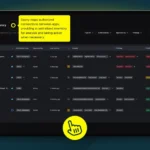SaaS solutions are at the heart of streamlining operations, enhancing productivity, and driving innovation. However, most organizations have hundreds of these apps, each with a different authentication process and a new set of credentials for users to memorize, leading many to adopt dangerous practices. To address this, many companies find comfort in the security of their Single Sign-On (SSO) solutions, believing they provide a protective blanket over all their SaaS tools.
This well-intentioned belief often turns out to be a dangerous illusion. IT departments still lack complete visibility over the vast array of SaaS apps, leaving many exposed and unprotected. In this article, we will explore the pitfalls of this misconception and the dangers posed by unmanaged SaaS apps, SaaS sprawl, identity visibility gaps, and the looming threat of identity breaches.
The Unseen Threat: Unmanaged SaaS Apps
As organizations grow, the number of SaaS apps in use can skyrocket, often without centralized oversight or approval. Departments seeking efficiency and new functionalities may adopt various tools without involving the IT department. This business-led IT leads to a proliferation of unmanaged SaaS apps or shadow IT that operate outside the formal security protocols established by the organization.
These unmanaged SaaS apps significantly increase organizational risk as they are not integrated into the SSO system. This means they often rely on weaker, separate passwords vulnerable to theft. IT cannot ensure these apps comply with security policies without proper oversight, exposing sensitive data to unauthorized access and potential breaches.
The Chaos of SaaS Sprawl
The uncontrolled expansion of SaaS apps creates a SaaS sprawl across the organization. It starts with a handful of tools that can quickly become an unwieldy mass of software, each with its own access controls and user permissions. This rapid growth often outpaces the IT department’s ability to manage and secure these applications effectively.
The lack of centralized control leads to inconsistent security practices and fragmented identity management. Users may have multiple accounts across different platforms, increasing the risk of credential fatigue and insecure password practices. Without comprehensive visibility, ensuring that all applications are secure and compliant becomes a near-impossible task.
The Identity Visibility Gaps
This rapid growth also leads to one of the largest SaaS security issues: a gap in visibility into what assets exist and who has access to them. Tracking and managing user identities and permissions across all platforms becomes increasingly challenging, creating a lack of visibility with blind spots where unauthorized access can go undetected for extended periods. It makes a situation where sensitive data may be accessible to individuals who no longer need it or, worse, to those who should never have had access in the first place. These gaps make it difficult to enforce the principle of least privilege and ensure that users are only granted the access they need to perform their jobs.
The Perils of Identity Breaches
Identity breaches are among the most devastating security incidents an organization can face. When user credentials are compromised, attackers can gain unauthorized access to critical systems, data, and services. The fragmented and unmanaged nature of many SaaS environments exacerbates this risk. With multiple applications not covered by SSO, each with different security standards and login credentials, the potential entry points for attackers multiply.
Moreover, the lack of visibility into these applications means that breaches may go unnoticed for extended periods, allowing attackers to move laterally within the organization and causing more significant damage. Such breaches’ financial and reputational costs can be catastrophic, underscoring the need for robust identity management and security practices.
The Illusion of Comprehensive SSO Coverage
Many organizations fall into the trap of believing that their SSO solution provides comprehensive coverage and protection for all SaaS applications. SSO is a powerful tool that centralizes and secures user authentication, allowing users to access multiple applications with a single set of credentials. However, this security blanket is only as effective as the scope of its coverage.
Many SaaS applications, especially those adopted through shadow IT, are not integrated into the SSO system. These applications remain outside IT’s control and lack the security benefits that SSO provides. The assumption that SSO covers all applications creates a false sense of security, leaving significant gaps that can be exploited by malicious actors.
Mitigating the Risks: Strategies for Comprehensive SaaS Security
Organizations must adopt a multifaceted approach to SaaS security to effectively mitigate the risks associated with the rapid adoption of SaaS apps and the subsequent security challenges. By acknowledging the limitations inherent in relying solely on Single Sign-On (SSO) solutions, companies can address the vulnerabilities hidden within their SaaS landscapes.
The cornerstone of a robust SaaS security strategy involves conducting automated, regular audits. These audits identify all SaaS apps currently in use within the organization, paying particular attention to those that may have been adopted without formal approval. It is crucial to ensure these applications are either integrated into the existing SSO system or managed securely. This comprehensive oversight can only be achieved with tools designed to provide a complete view of the organization’s SaaS environment, enabling IT departments to close security gaps effectively.
Beyond mere identification, centralizing SaaS management is pivotal. Implementing a unified platform to manage and monitor all SaaS apps enhances the organization’s ability to maintain visibility over user access and permissions. This centralized approach not only streamlines management but also ensures consistent application of security policies across the board, significantly reducing the risk of breaches due to inconsistent security practices.
However, technology alone cannot fully protect an organization; human factors play a critical role. Developing and enforcing shadow IT policies that regulate adopting new SaaS tools is essential. These policies should require approval from the IT department for new software and its integration into existing security frameworks. Additionally, just-in-time security guardrails and training can empower employees to recognize and thwart cybercriminals’ phishing attempts and other social engineering tactics.
Moreover, strengthening identity management through advanced Identity and Access Management (IAM) solutions provides a deeper layer of security. These solutions offer a comprehensive view of user identities and permissions across the organization, supporting the enforcement of the least privilege principle—a key strategy in minimizing the risk of unauthorized access.
Education is another critical component. Employees must be aware of the risks associated with shadow IT and the importance of utilizing approved tools and the organization’s SSO system to access SaaS applications. Informed employees are the first line of defense against security breaches, as they are better equipped to adhere to best practices and recognize potential threats.
By taking these proactive steps and moving beyond the false security provided by incomplete SSO coverage, organizations can effectively safeguard their SaaS environments against the myriad threats accompanying unchecked SaaS sprawl and identity visibility gaps. Protecting an organization from these hidden threats requires a vigilant, well-rounded approach to SaaS security.
Breaking the Illusion With Savvy
Effective management of SaaS apps is crucial for controlling costs, maintaining robust security, and ensuring seamless operations. Organizations can mitigate risks, boost productivity, and achieve a better return on investment from their SaaS deployments by addressing the hidden costs associated with unmanaged SaaS accounts.
Savvy offers a comprehensive SaaS management solution designed to address these challenges. With features like comprehensive visibility, automated security, and no-code automation, Savvy helps organizations manage their SaaS apps efficiently. By choosing Savvy, you can ensure that your organization remains secure, compliant, and financially efficient in managing its SaaS ecosystem.



